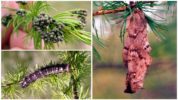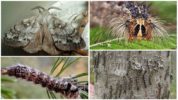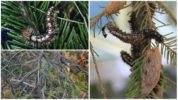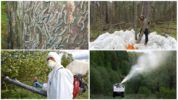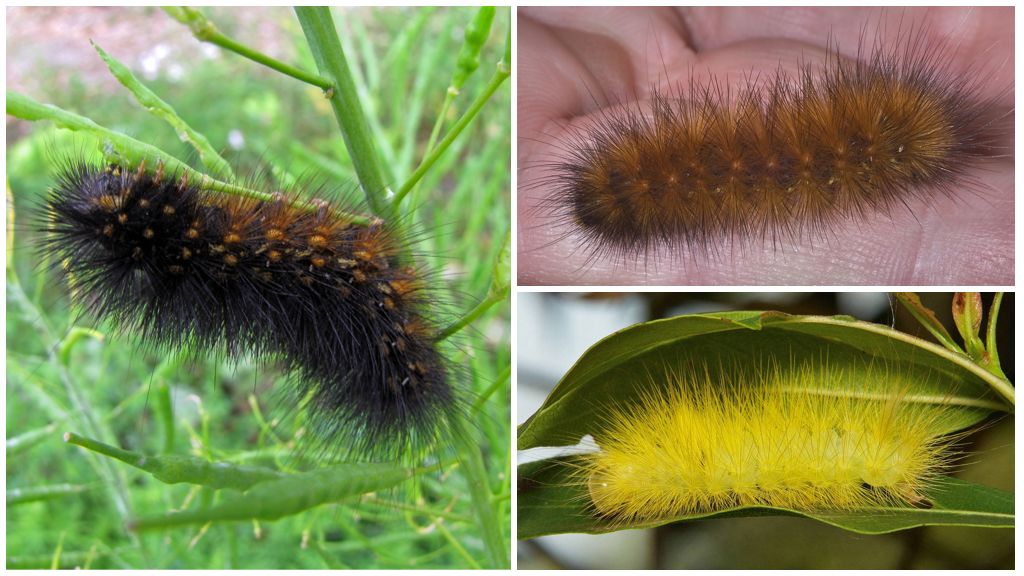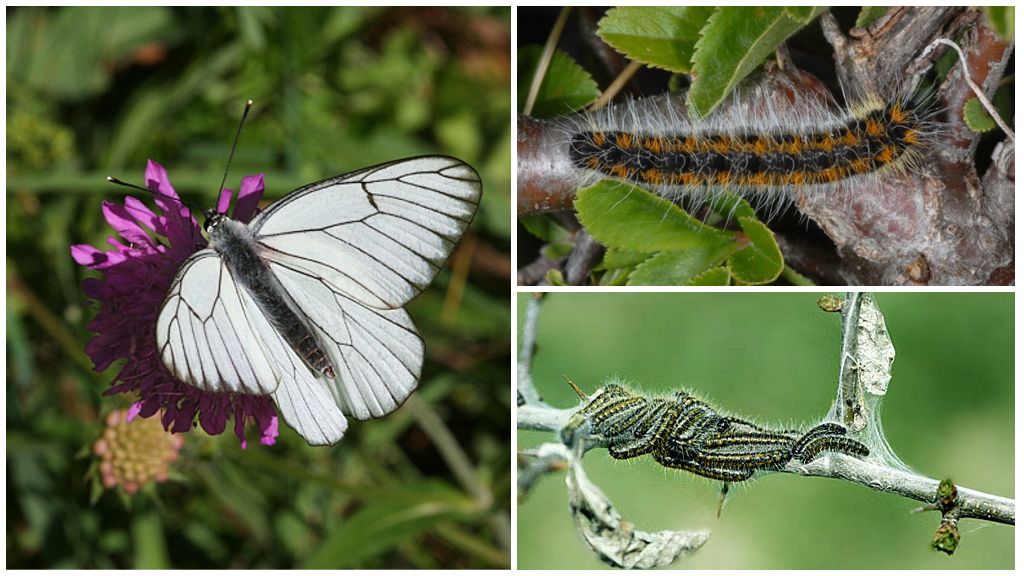- Eggs, caterpillar and cocoon of the Siberian silkworm
- Caterpillar and butterfly of the Siberian silkworm
- Caterpillars of the Siberian silkworm
- Fight against the Siberian silkworm
Siberian silkworm is widely known to residents of the Ural, Siberian, Far Eastern regions. The caterpillar of the Siberian silkworm is a pest that parasitizes on needles. Prefers larch, less likely to suffer from the invasion of fir, spruce. With a large number of larvae of the Siberian silkworm on a tree, the plant stops developing, needles turn yellow, fall off. Man has to take measures to control butterflies and their caterpillars.
Appearance
The Siberian silkworm is a large butterfly with a wingspan of up to 80 mm (photo below). Males differ from females in smaller sizes, the presence of scallop tendrils. The color is tan, brown, gray, black. On the front pair of wings are patterns, bright spots. Hind wings in plain colors. A photo of the Siberian silkworm at the adult stage is presented below.
Ball-shaped eggs up to 2 mm in size (photo below). Initially, the eggs are bluish-green in color, gradually changing color to brown.
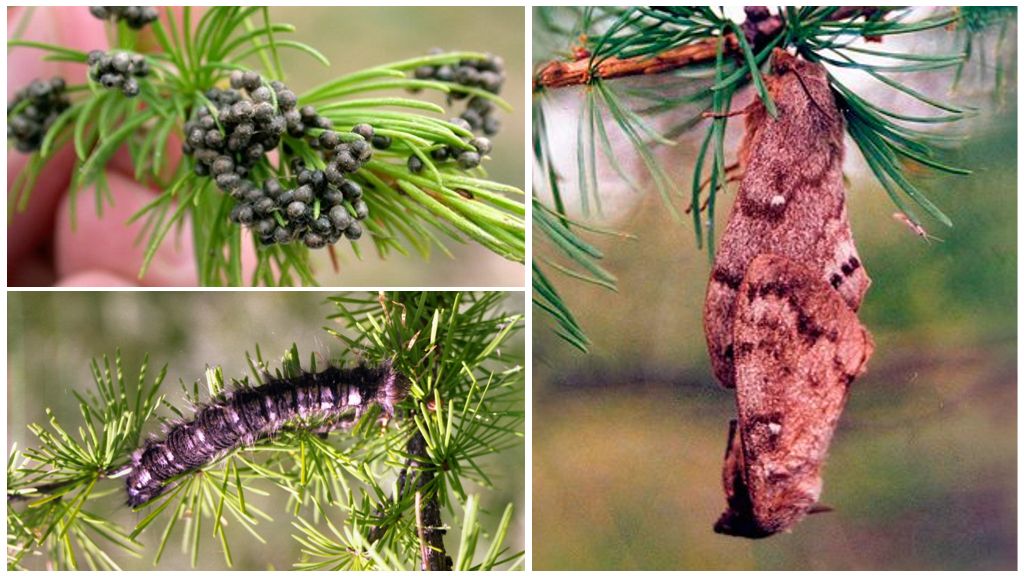
On a note!
The color may vary depending on where the female laid the egg - on the bark of trees, stem, leaves. Eggs of the Siberian silkworm are arranged in heaps or one at a time. Photo can be seen below. In one masonry can be about 200 pieces.
Caterpillars of the Siberian silkworm are born miniature - about 2 mm. Eat well, grow fast. At the last stage of development, the body length of the larva is 70 mm. Color is changeable - from green to brown and almost black. On the body, you can see the stripes of purple, spots. Caterpillars pass 4 molt, constantly increasing in size. A photo of the offspring of a butterfly can be seen further.
At the end of development, the caterpillar of the Siberian silkworm turns into a chrysalis. The cocoon forms from silk thread, which itself produces. Clings its paws to the bark of trees, the stem, leaves, freezes. Cocoon size up to 40 mm. Initially, the covers are light, then acquire a brown shade, black, which is clearly visible in the photo of the cocoon of the Siberian silkworm.
Development features

Years of butterflies begin in the second half of July, lasts about a month. Mating takes place on the fly. The male dies shortly after fertilization, the female finds a favorable place for laying eggs. Fastens them to the bark of trees, leaves with the help of a special sticky substance that is released along with the eggs.
Development the larvae inside lasts up to 22 days, under favorable conditions, young offspring of the Siberian silkworm appears already on the 13th day. Caterpillars of the first age actively feed on needles, grow rapidly. In the period from August to September, they significantly increase in size, the chitin cover is condensed. The cycle in the photo. At the end of September, caterpillars climb under the bark, forest litter, and remain wintering.
With the onset of heat - in May, the larvae rise to the crowns, live and eat there throughout the warm season. The second wintering of the caterpillar is carried at the fifth to sixth age. Continue development in May, pupate by the end of June. The development of a butterfly in a cocoon lasts about a month.Outwardly - a motionless being, inside - complex processes of transformation take place. In early September, young butterflies appear. Their task is to find a secluded place for wintering. Below is a photo of the young.
On a note!
Development caterpillars occurs for 2-3 years, while butterflies at the adult stage live no more than a month, do not feed on anything. Energy reserves are enough to lay about 300 eggs at a time.
Sabotage
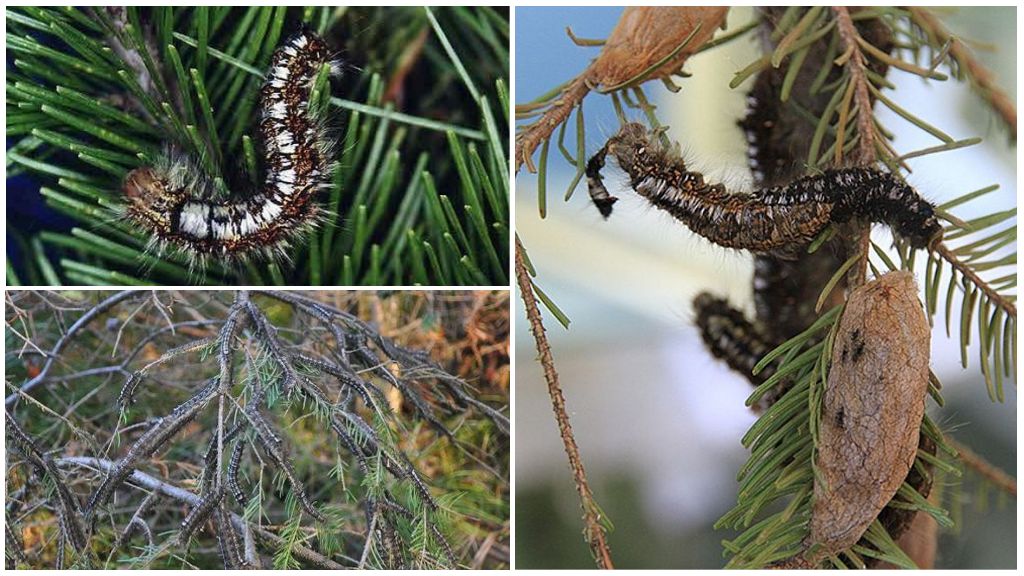
The Siberian silkworm is dangerous, it is not difficult to guess. Due to the fact that the development of the larvae lasts for several years, and every spring they rise in crowns, there is a risk of a weakening of the tree.
Butterflies spread their numerous offspring on different plants. In July, mass infection covers several million hectares of forest. This causes tremendous damage to forestry. The natural enemies of the Siberian silkworm are goldfish, bark beetles, barbel. The photo can be seen further. Since bark beetles also harm coniferous plantations, the extent of wrecking increases by several times. Birds of prey eat insects.
In the mid-90s, the struggle with the larvae of the Siberian silkworm lasted 4 years. Then, about 600 thousand hectares of forest area suffered from the pest invasion. Cedar trees died, which were of great value to local residents.
Over the past 100 years, 9 outbreaks of mass wrecking of silkworm caterpillars have been observed in Siberia. They managed to stop the reproduction due to the use of modern insecticides. Measures to combat Siberian silkworms on pine and other plants are taken constantly, if not to destroy the caterpillars, so to prevent their appearance. A photo of the mass destruction of plants is presented below.
Interesting!
Sericulture is especially developed in China. Natural silk, which is obtained from threads, is valued silkworm. Insects are specially bred on mulberries, provide all the necessary conditions of existence. Cocoons are collected, preventing butterflies from appearing in the light. The length of the threads of one cocoon is about 900 m. Butterflies lead a sedentary lifestyle, practically do not fly. Larvae are not dangerous to surrounding plants.
Methods of struggle

Caterpillars damage larch, oak, beech, birch, pine, spruce, aspen, fir, cedar, pearmaple tree. Unmatched silkworm prefers deciduous trees, but does not disdain conifers. Larvae of the first age feed on the day, as they grow older they switch to a hidden lifestyle - crawl out of shelters at night.
The main control measures:
- Collection and destruction of ovipositions. In small areas, young trees are scraped off manually, trampled underfoot or thrown into the fire. Below is a photo of infected plants.
- In late autumn or early spring, eggs are destroyed with the help of petroleum products - gasoline, kerosene, machine oil. However, you should always remember that these are flammable substances, if used improperly, the risk of a massive fire increases.
- Glue rings are used against the larvae, which are placed at a level of 1.5-2 m above the ground, which does not allow pests to reach the crown.
- In small areas of caterpillars collected manually, then destroyed in any way.
- The most effective method is insecticidal substances. Spray crowns, tree trunks. Processing is allowed in the early spring before flowering trees or after. The action of the poison lasts for 20-45 days. Reprocessing is carried out as necessary.
Every autumn, spring, you need to carefully examine the tree bark for eggs, larvae, coat the trunks with a solution of lime, chalk. The life cycle of an insect spans several years, so there is always a threat of infection. Propagation to other trees occurs either in early spring or late autumn.In the photo, you should carefully consider the pest in order to later respond to the problem in a timely manner.
